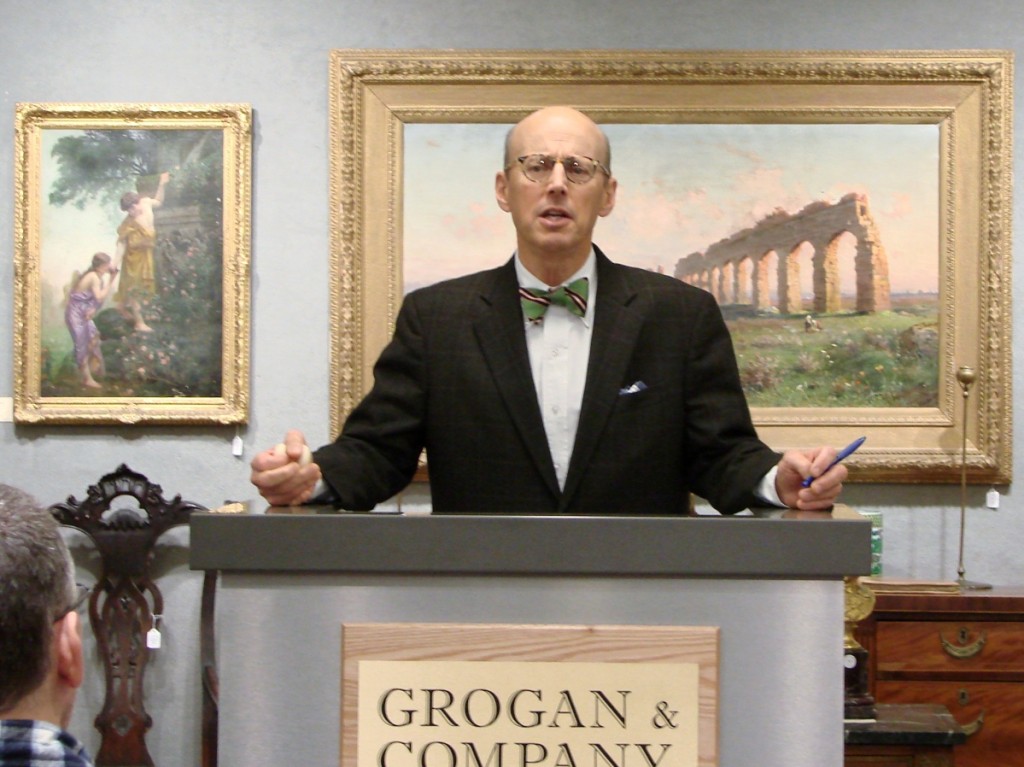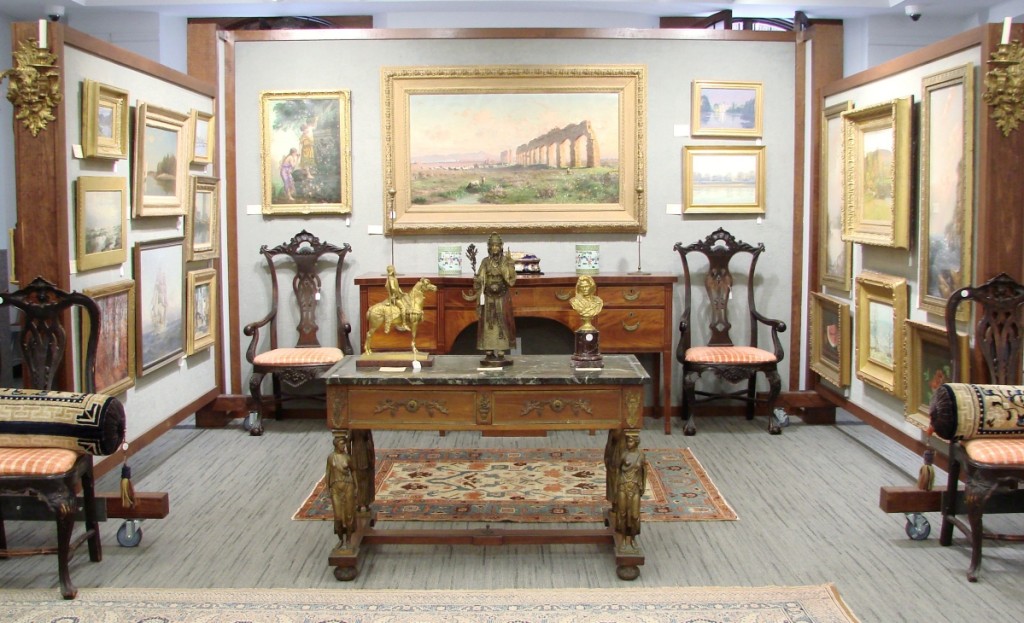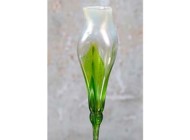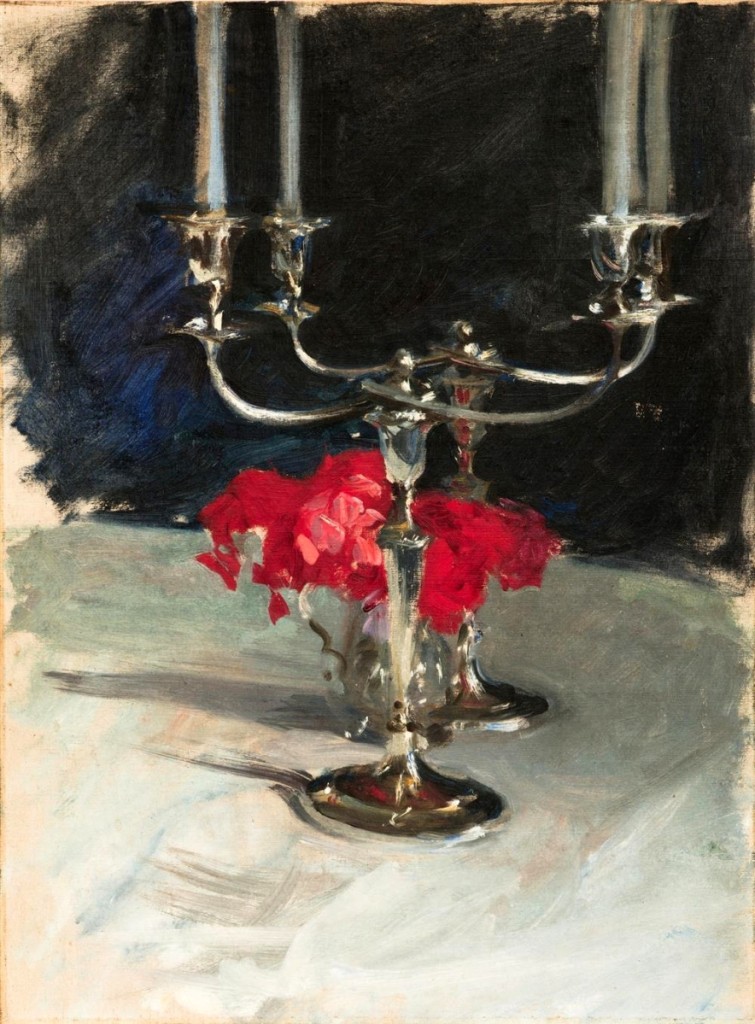
The highlight of the sale was “Candelabra With Roses” by John Singer Sargent, which sold to a retail buyer on the phone for $457,000. Sargent was friendly with fellow artist Francis Davis Millet and his wife, Lilly. He vacationed with them in the Cotswolds in 1885 and 1886. This painting is believed to date to that time. It has descended in the Millet family.
Review and Onsite Photos by Rick Russack, Additional Photos Courtesy Grogan & Co.
BOSTON – Grogan & Company’s 30th anniversary sale, November 5, grossed $2,525,000 as a John Singer Sargent (1856-1925) painting brought $457,000, a diamond ring realized $207,400, two other pieces of jewelry each sold for more than $100,000, and an important group of mammoth plate photographs of Yosemite by Carlton Watkins fetched more than $187,000. The final total was almost evenly split between the jewelry portion of the sale and the fine arts, with jewelry bringing in slightly more.
The sale was strong throughout, with relatively few lots passed. It was standing room only in the gallery as the sale started, multiple phone lines were in use throughout the sale, and internet bidding was available on two platforms. Grogan & Company is a family-run business, with the jewelry portion of the business managed by Michael Grogan’s daughter, Lucy. Georgina Winthrop, Grogan’s gallery manager and fine arts specialist, researches the material and prepares the catalog entries. When appropriate, her descriptions are detailed and extensive.
Sargent was friendly with fellow artist Francis Davis Millet and his wife, Lilly. He vacationed with them in the Cotswolds in 1885 and 1886, and his still life “Candelabra With Roses” is believed to date to that time. The painting, according to the catalog, “relates in motif to several other Sargent works from the early to mid-1880s, including a number of bright flowers…” The painting descended in the Millet family and was conservatively estimated at $100,000. A retail buyer, bidding on the phone, was ultimately successful.
In addition to the Sargent, several other paintings did well. Finishing at $57,950, the second highest priced painting in the sale was “Horse and Rider” by Milton Avery (1885-1965). The painting bears a label on the reverse, stating, in part, “This early Milton Avery painting was gifted by the artist to Marion Dunham, a New York city lady, in the late 1920s or early 1930s. The painting descended through her family for several generations.”
Also doing well was an early, impressionistic-style painting by William McGregor Paxton (1869-1941), a portrait of Ruth Gaston at the age of three. It was commissioned in 1899 by the child’s father. The painting has hung in family homes since that time. Paxton’s impressionist-style paintings are quite rare, as most were destroyed in a studio fire in the early Twentieth Century, and this one sold for $30,500. A theatrical portrait by Ben Ali Haggin (1882-1951) earned $18,300. It was an almost life-sized painting of Juliette Day in one of her earliest roles, as Moy Fah Loy in “Yellow Jacket,” a play that ran for 80 performances in New York in 1912-13. The actress’s husband, Paul Whitney, purchased the painting for $5,000 in 1924. In addition to being a skilled portraitist, Haggin designed stage sets and tableaux vivants for society gatherings.
There were a number of paintings by Rockport school artists. “New England Winter” was one of two by Aldro Thompson Hibbard (1886-1972), and it brought $10,980. “Winter Loggers Mount Mansfield,” signed and dated 1948, did better, finishing at $27,450. “Sailboat in the Harbor” was one of two by Emile Albert Gruppe, and it sold for $6,100. The second, “Vermont Hillside,” a winter scene, reached $5,795.
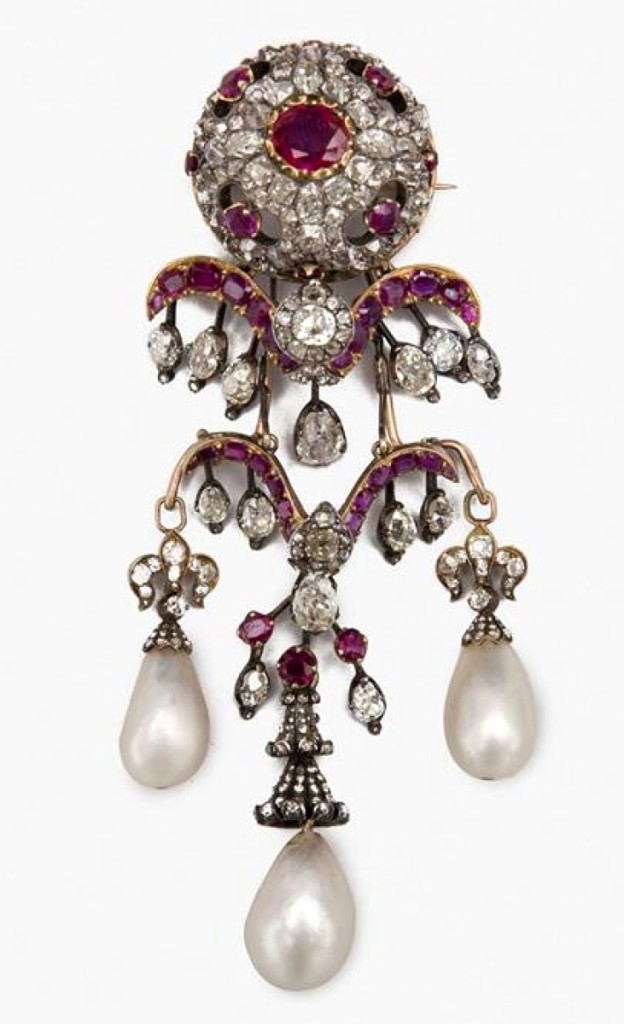
This gold, silver, ruby, diamond and natural pearl brooch once belonged to Eugénie de Montijo, wife of Napoleon III and sold for $170,800. When she and her husband fled Paris after the Franco-Prussian war, she took her jewels with her and sold this piece. It eventually came into the possession of Mrs Ernest Raphael. John Singer Sargent painted a portrait of Mrs Raphael wearing the brooch in 1905.
The jewelry selection, comprising about 145 lots, grossed $1,170,000, topped by a platinum and diamond ring, which realized $207,400. The emerald-cut 8.31-carats diamond was accompanied by a GIA certificate grading it to be F (colorless), SI 1 (slightly included),with no fluorescence. Two other pieces finished above $100,000. A yellow gold, silver and diamond riviere necklace, comprising 40 graduated old mine-cut diamonds, 50 total carat weight, mounted in silver-topped yellow gold, with a French assay mark on the clasp, realized $146,400. Selling for $170,800 was a gold, silver, ruby, diamond and natural pearl brooch that had once belonged to Eugénie de Montijo, wife of Napoleon III.
Earlier this year, a picker brought in a group of photographs that he had acquired when cleaning out a home in Massachusetts. He did not know much about them and, in fact, had just put them aside and ignored them for about a year. It turned out that they were an important group of early photographs of Yosemite by one of America’s most important landscape photographers, Carleton Watkins, and the group of 20, collectively, sold for $187,514. These were “mammoth plate” views, each about 16 by 20 inches, taken in the 1860s. These were not enlargements, they were made using the very cumbersome wet-plate process, on glass negatives of that size. As a result, they were crisp images, not softened as enlarged images sometimes are.
Weston Naef, founding curator, the J. Paul Getty Museum’s department of photographs, and author of books and articles about western landscape photographers, had seen the photographs at Grogan earlier this year and was asked about them. Naef said, “The hoard of Watkins mammoth plate photographs at Grogan & Co. is unusual. The negatives were all made in the Yosemite Valley, during the 1865 and 1866 seasons, when Clarence King was in charge of the California Geological Survey in Yosemite. My 1975 book, Era of Exploration: The Rise of Landscape Photography in the American West, has a chapter on Watkins where I discuss King and the 1865-66 seasons. Seven items in the group range from very desirable to highly desirable from a collector’s standpoint. Several of Watkins mammoth plate views are only known from single copies.” According to Naef, 86 percent are represented by three copies or fewer.
“What makes some of the Grogan prints so desirable is the confluence of their overall importance in Watkins’ body of work combined with their rarity and condition,” Naef continued. “For example the one that was titled by Watkins as ‘First View of Yosemite Valley from the Mariposa Trail’ was listed as ‘no. 1’ when Watkins made a catalog of more than 700 of his mammoth plate negatives. It is found on page 58 of Carleton Watkins: The Complete Mammoth Photographs [co-authored by Naef]. It is among the dozen or so most important pieces in Watkins’s entire body of mammoth plate work that consists of almost 1,300 images. A total of ten prints are known to exist, six of which are in museum or library collections.”
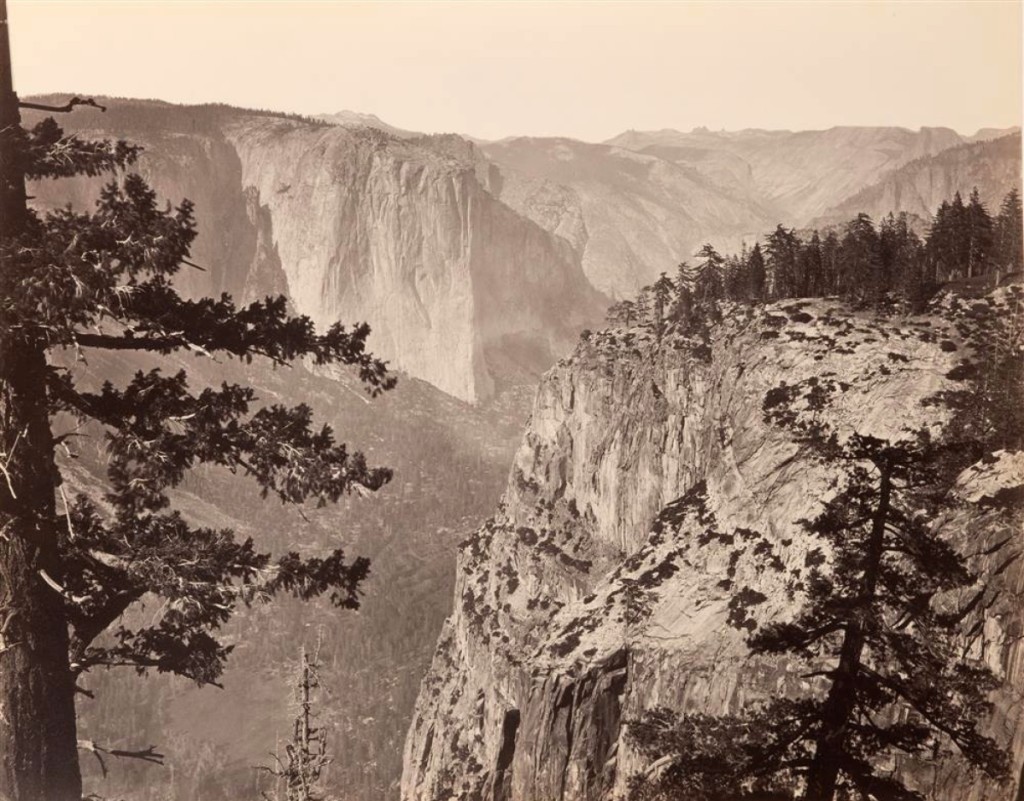
Weston Naef, founding curator, the J. Paul Getty Museum department of photographs, stated that this mammoth plate photograph by Carlton Watkins would be included in any list of the 100 most important American photographs of all time. Only ten copies of this photograph, “First View of Yosemite Valley from the Mariposa Trail,” are known to exist, six of which are in museum collections. At $27,450, Naef called it “a bargain.”
The key point, according to Naef, is that the print being sold by Grogan & Co. is of exceptionally high quality with rich, purple-gray tones and unblemished sky. “Moreover, this image would certainly fall into any list of the 100 most important American photographs of all time,” he said.
This print sold for $27,450, which Naef later called “a bargain.”
After the sale, Michael Grogan was asked about his 30 years in the auction business. “It’s been great and it’s made me a generalist,” he observed. “Before starting this company, I worked at Sotheby’s, a specialist eventually running the rug department. Now I consider myself a ‘generalist.’ I’ve had to learn about a wide range of things, like the Watkins photos in this sale, and Willard clocks and Picasso ceramics, and so on. That’s the most satisfying part of the job. I also know now that we have to adapt, as times change. We can’t just continue to do business the way we used to. I’m fortunate to be surrounded by very bright young people – my daughter Lucy, Georgina Winthrop and Taylor See, our auction coordinator. They keep me on my toes.”
When asked to recall one memorable item that he sold, he immediately responded, “I think my favorite single item would have been a copy of Paul Revere’s print of the Boston Massacre. In 2004, we sold a bunch of stuff for a 93-year-old woman in Needham who was still living in the house she grew up in. We had put aside some trunks of things that no one thought much of. After the sale, I was going through the trunks and found the Revere print. When I looked at it closely, I saw that it was an original, and I called the attorney with which we were dealing with the good news. We sold the print for $195,000, and the woman donated the money to the music program at her church. I’ve sold things for much more than that, but that’s the kind of story I like to tell.”
Also, after the sale, Lucy Grogan said the jewelry outperformed her expectations. “I think one reason we did so well was that we had so many high-quality pieces,” she said. “That brings more potential bidders to our website and they spend more time looking at things.” She was asked how her use of social media impacts the jewelry sales. She has been using Instagram to promote jewelry sales, has more than 4,700 followers and said that the platform has driven traffic to the Grogan & Co. website. “I can tell that it works from the number of people who ask me questions about things they’ve seen on Instagram. Four or five pieces that were sold in this sale went to Instagram folks, and there was a young couple in the room who live in the neighborhood. They learned about us from Instagram and they bought some things and were underbidders on other things. It works.”
Prices reported include the buyer’s premium.
For information, 617-720-2020 or www.groganco.com.

